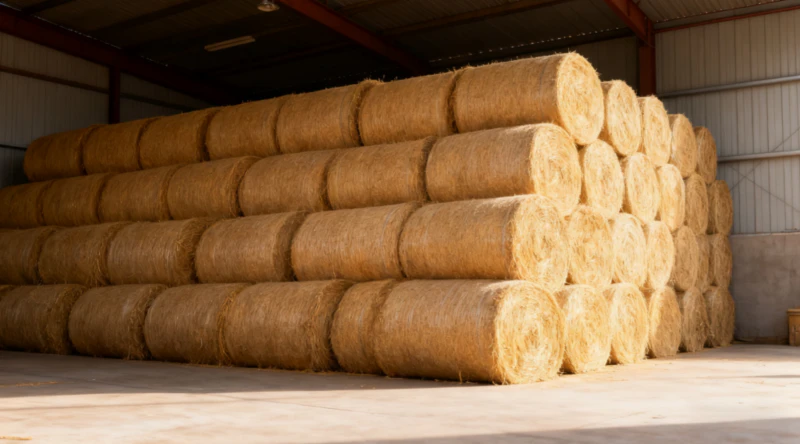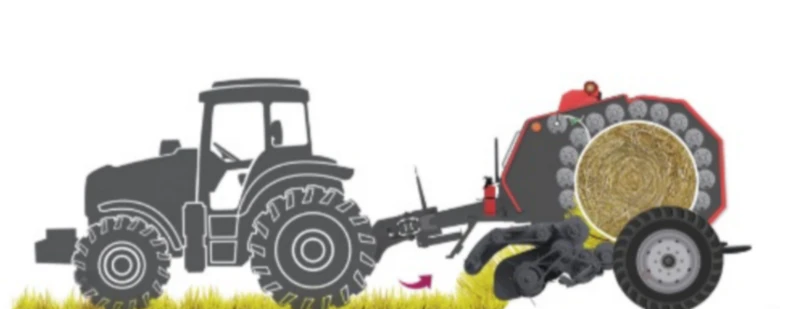Forage Balers: Maximize Feed Value and Nutrient Preservation
Our forage balers are designed to help you preserve nutrients and improve the quality of your feed. Explore our innovative solutions and find the right machine for your farm.
Are You Facing These Forage Challenges?
• Nutrient Loss: Ensuring your feed retains maximum nutrients for livestock health.
• Weather Risks: Protecting your harvest from adverse weather conditions.
• Poor Feed Quality: Improving feed consistency and quality for optimal livestock performance.

Our Solution: High-Efficiency Forage Balers
•Multi-stage compression: Ensures tight bales and maintains optimal feed quality.
• Dust removal system: Reduces dust, ensuring high-quality, dust-free feed.
• Durable construction: Long-lasting and requires minimal maintenance.

How Our Forage Baler Turns Your Field into Premium Feed
Straw Collection and Baling Stage
Straw Collection and Baling Stage


Patents and Certificates
The company holds nearly 100 technology patents, ISO certification, CE certification, product patents, industry awards, etc. and its product development is entirely computer-aided design, possessing independent testing capabilities. The company has two production lines for round balers and cutting machines, each with an annual capacity of 2,000 units, equipped with nearly 100 advanced pieces of equipment, including CNC laser cutting machines, automatic welding lines, and electrostatic spraying production lines.
Our products are sold to over 30 provinces and cities in China and exported to countries such as Mongolia and Russia. In 2023-2024, we ranked first in sales of round balers nationwide, maintaining a leading market share for four consecutive years. The company actively participates in international exhibitions such as the China-Russia and China-Mongolia Expos, achieving outstanding performance in markets like Russia and Mongolia, securing numerous orders and establishing long-term customer relationships. Adhering to the service tenet of “starting with customer needs and ending with customer satisfaction,” the company focuses on lean manufacturing, continuously promoting the intelligent upgrading of agricultural and livestock machinery, and is committed to becoming a leading enterprise in China’s agricultural and livestock equipment industry, providing high-performance, cost-effective solutions to global customers.


Engineered for Superior Silage Quality and Reliability

Our independently developed core knotter has completely resolved the “chokepoint” challenge, achieving a stable knotting success rate of 99.8%. Compared with brands relying on imported knotters, this not only eliminates the problem of long accessory procurement cycles but also reduces the rope jamming failure rate from the industry average of 3% to below 0.5%. Equipped with a 2.26-meter widened pickup width and a dual-crank compression mechanism, the baler boasts a miss-pick rate of less than 1% and an hourly operational capacity of 8-15 mu (1 mu ≈ 0.0667 hectares), significantly exceeding the 5-10 mu of similar models. Even when dealing with tall-stalk crops, it can achieve highly efficient operation with “one sweep to collect all”.
Our competitive advantages are further reflected in full-cycle services and cost control, ensuring users get good value for their money and a hassle-free user experience. Leveraging over 200 service outlets nationwide and the Beidou Operation Tracking Platform, we have innovated the “1+N” proactive service model, achieving a 92% on-site arrival rate within 5 hours of after-sales requests—far higher than the industry average response time of 6-8 hours. This completely eliminates users’ concerns about machine downtime during the busy operation season.
In terms of cost, as a key recommended product in the national subsidy catalog, users can enjoy a maximum discount of 30% when combined with provincial subsidies. The investment payback period is only 1.8 operation seasons, nearly half a cycle shorter than that of brands like Zoomlion and Starlight. The machine body is made of 8mm high-strength structural steel, 2mm thicker than that of ordinary models. Combined with a closed transmission system, its service life is extended to over 8 years, and the residual value rate of used machines is 8 percentage points higher than the industry average. Whether for large-scale farms or small and medium-sized farmers, our baler enables the maximization of long-term benefits.
Your success, our case study
Customer Name and Location: Green Valley Ranch | Texas, USA
Customer Pain Point: “We face significant rainfall uncertainty, posing a huge challenge to hay drying time and nutrient preservation.”
Solution: Utilized the S9000 baler with a “real-time monitoring” system.
Results:
Bale density increased by 25%, and transportation costs were significantly reduced.
Nutrient preservation exceeded 85%, resulting in higher-quality hay that commanded premium prices from buyers.
Single-season processing volume exceeded 5,000 acres, with zero equipment malfunctions.
Customer Testimonial: “This equipment is a game-changer for us. Even during the rainy season, we can produce high-quality bales, which directly improves our bottom line.” — John Smith, Farm Manager


Customer Name and Location: La Ferme Modern | Normandy, France
Customer Pain Point: “We needed a high-efficiency round baler solution that could handle a variety of crops and adapt to sloping terrain.”
Solution: Deployment of the S9000 Classic Baler.
Results:
Operating efficiency up to 30 bales/hour, perfectly handling diverse crops.
Excellent sloping terrain adaptability, no risk of sideslip, safe operation.
Overall operating costs reduced by 18%.
Customer Testimonial: “We are impressed by its reliability and powerful performance. It is now an indispensable asset on our ranch.” — Pierre Dubois, Farmer
Frequently Asked Questions (FAQ)
What is a forage baler?
A forage baler is a machine that compresses hay, straw, or other forage into compact bales for easier storage and transport. Our machines are designed to maximize feed quality and minimize waste.
How do I choose the right forage baler for my farm?
The best baler for you depends on your farm size, forage types, and specific needs. Contact us, and our team will help you select the perfect baler for your operations.
Do you offer global shipping?
Yes, we ship worldwide and provide tailored solutions for farms across the globe, from large-scale operations to small farms.
Contact Us for Custom Solutions
We will reply within 24 hours.
